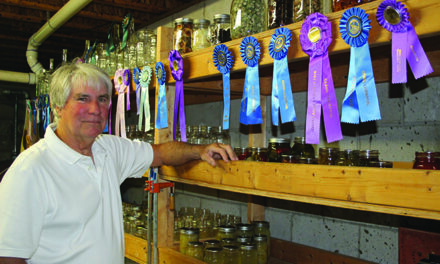
Garden gurus say that flowers with four petals pointing up and just one down indicate a pansy, while flowers with two petals pointing up and three pointing down signify viola. (Photo by Micheal Rhian Driscoll)
When it comes to favorite fall flowers, mums and pansies are traditionally the stars of the cooler weather garden.
But violas, the less flashy, more petite cousins of the pansy, provide a greater number of blooms per plant atop trim stems and pack an impressively thick swath of color in whatever corner garden section they grace.
Proving again that size alone is no indicator of strength, the more diminutive violas are, in fact, the hardier of the two specimens when it comes to chilly weather toughness and heat tolerance.
This often-unsung sweetheart of the autumn landscape is worth looking into.
But be prepared – asking for information using the word “viola,” especially typing the word into a search engine, can lead you down a long and winding (though lovely and enlightening) garden path.
Viola is the genus name covering 500 varietals including violet, pansy (Viola x Wittrockiana), panola, and the bedding plants called Viola, hybrids developed from crossing Viola cornuto (horned or tufted violet) with other species, which are found at the garden center.
The family grouping also encompasses native wild violets that bring charm to woodlands and sometimes headaches to carefully manicured lawns.
Though “new and improved,” the current crop of modern viola has in its historical lineage the heralded heirloom perennial Sweet Violet, Viola odorata.
Johnny-Jump-Ups, the most recognized “grandma grown” violas, known also by the names Viola Tricolor and heartseace, are descendants of a smaller species of pansy that once grew wild. For that reason, all pansies technically are violas, yet violas are not inevitably pansies.
Pansy blooms are characteristically 2 1/2 inches wide often with splotches of color resembling faces, while violas are frequently described as closer to nickel-sized, adorned with wisps of fine lines or “whiskers.”
The hybrid Patiola series viola mixes the large pansy sized flowers with viola’s hardiness.
Other hybrid “series” include the also larger blossomed ‘Sorbet’ (according to Louisiana State University, which declared them an exceptionally cold hardy “super plant”), “Penny,” “Jewel” “‘Gemini” and “Princess.”
If you struggle telling the two apart, garden gurus say that flowers with four petals pointing up and just one down indicate a pansy, while flowers with two petals pointing up and three pointing down signify viola.
There is also ongoing debate over whether violas are annuals or perennials. The Burpee company categorizes them as perennial, but also recognizes that gardeners often treat them as annuals, replanting in the fall after extreme summer heat causes them to fade. (By consistently deadheading blooms and trimming leggy stems, especially during the hot months, can help preserve them for coming back as the season transitions to fall.) But horticultural literature has traditionally referred to them as cold hardy annuals.
Remember those wild violets invading your tidy grassy expanse? Violas, too, are self-seeders and can spread and sow in unexpected places. A blanket of snow will tide them over until early spring arrives.
This free ranging style has led some gardening experts to recommend container plantings, even window boxes, over beds, borders and edgings, as a tidier way to enjoy their charm.
With fresh viola blooms in your fall garden, these edible herbals can also provide attractive and tasty garnish to crisp salads and enchanting adornment to cookies, cupcakes and other baking season goodies.




